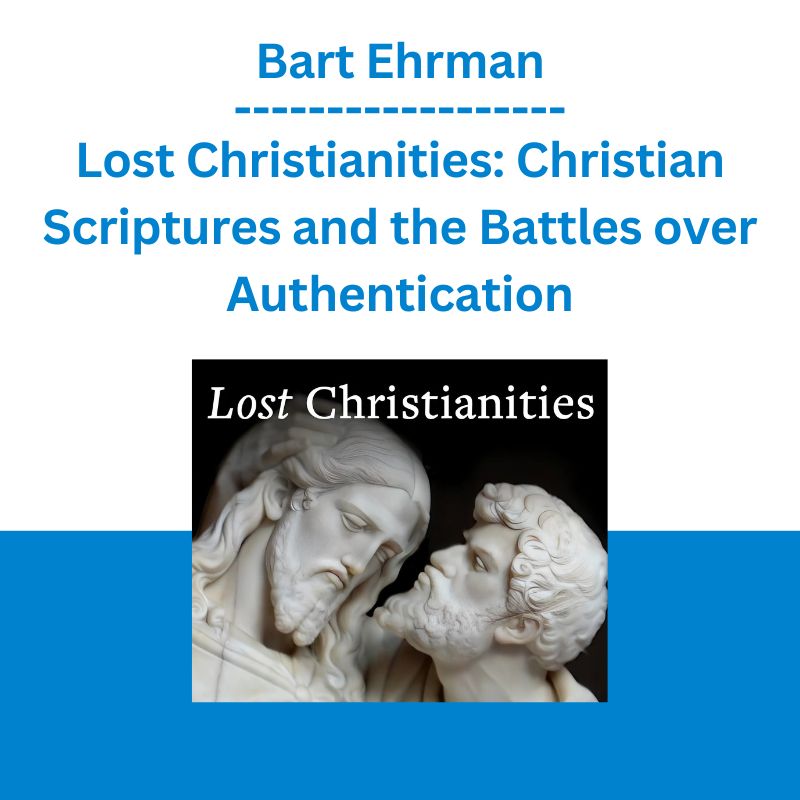*** Proof of Product ***
Exploring the Essential Features of “Bart Ehrman – Lost Christianities: Christian Scriptures and the Battles over Authentication”
Lost Christianities: Christian Scriptures and the Battles over Authentication
Discover myriad works of early Christianity that failed to make the official canon and become part of the Bible in this course by best-selling author and Professor Bart D. Ehrman.
LECTURE (24)
01:The Diversity of Early Christianity
Modern Christianity is widely diverse in its social structures, beliefs and practices, but this diversity is mild compared to the first three centuries A.D., when Christians disagreed on such basic issues as how many gods there were, or whether Jesus was human, divine, both, or neither.
02:Christians Who Would Be Jews
This begins by considering key terms used in the course, such as orthodoxy and heresy, followed by an introduction to the Ebionites, who maintained Jewish practices while believing that Jesus was the messiah.
03:Christians Who Refuse To Be Jews
This lecture examines the Marcionites, a group of heretics diametrically opposed to the Ebionites. Using the apostle Paul as his source, their leader, Marcion, insisted that true Christianity had nothing to do with Judaism.
04:Early Gnostic Christianity-Our Sources
The Gnostics believed that special knowledge brought salvation to souls trapped in the evil, material world. Before 1945 and the discovery of the Nag Hammadi library, information about this widespread group of Christian sects came almost solely from the writings of Irenaeus, Tertullian, and other church fathers who opposed them.
05:Early Christian Gnosticism-An Overview
This lecture provides an overview of the Gnostic religions. It considers their possible origins within a Judeo-Christian tradition that maintained that God had created the world and controlled it. This was hard for some Jews and/or Christians to accept.
06:The Gnostic Gospel of Truth
One of the most intriguing documents from the Nag Hammadi library is the Gnostic Gospel of Truth. It does not relate stories about the life of Jesus, but instead celebrates the “good news” that Jesus brought. The views of God, the world, Christ, and salvation here stand in stark contrast with those that became orthodox within Christianity.
07:Gnostics Explain Themselves
This lecture considers two writings that attempted to explain the Gnostic system to outsiders. Ptolemy tries to show that neither the one true God nor the Devil could have inspired the Old Testament. In the Treatise on the Resurrection, the anonymous author insists that, contrary to the claims of proto-orthodox Christians, the resurrection is of the spirit, not the flesh.
08:The Coptic Gospel of Thomas
The Gospel of Thomas is the most significant Nag Hammadi document. It consists of 114 sayings attributed to Jesus, with no reference to his miracles, death, or resurrection.
09:Thomas’ Gnostic Teachings
Understanding the Gnostic story can help explain the teachings in the Coptic Gospel of Thomas. Rather than the savior who dies for the sins of the world, Jesus is portrayed as the divine teacher who reveals the truth necessary for salvation.
10:Infancy Gospels
The Gospels of the New Testament say very little about Jesus’ life as an infant and young boy. This “lost period” is the subject of several early Gospels, however, including the Proto-Gospel of James, and the Infancy Gospel of Thomas.
11:The Gospel of Peter
A fragment is all that remains of the Gospel allegedly written by Jesus’ disciple Peter. Early writings proclaim it a forgery. This description of Jesus’ trial, crucifixion, and resurrection is both similar to, and strikingly different from, canonical accounts.
12:The Secret Gospel of Mark
In 1958 at the Mar Saba library near Jerusalem, scholar Morton Smith found a fragment of a letter supposedly written by the 2nd-century church father Clement. It indicated that a second edition of Mark’s Gospel existed, and was intended only for the spiritually elite. Is this letter authentic or a modern forgery?
13:The Acts of John
To some extent, the noncanonical Acts are modeled on the Book of Acts in the New Testament. They differ, however, in that each is about only one of the major apostles in early Christendom: John, Peter, Paul, Andrew, and Thomas.
14:The Acts of Thomas
The Apocryphal Acts resembled the ancient romances (novels). While the Christian Acts use many of these conventions, their goal is to counteract the views that the romances embraced.
15:The Acts of Paul and Thecla
One of the most popular apocryphal accounts from Christian antiquity involved the conversion and exploits of Thecla of Asia Minor, an aristocratic woman who converts to the Christian faith through the preaching of Paul.
16:Forgeries in the Name of Paul
A number of letters survive that are credited to the apostle Paul, but which were clearly fabricated. This lecture considers two sets of such correspondence. Evidently forged in the fourth century, these letters were meant to portray Paul as equal to the greatest minds of his day.
17:The Epistle of Barnabas
The Epistle of Barnabas is not considered forged. Although later attributed to Paul’s traveling companion Barnabas, it is actually anonymous. This is one of the most virulently anti-Jewish treatises of Christian antiquity.
18:The Apocalypse of Peter
This lecture examines an Apocalypse of Peter completely unrelated to the one previously discussed. This is a proto-orthodox composition that represents the first surviving narrative of a guided tour of heaven and hell, a forerunner of Dante’s Divine Comedy.
19:The Rise of Early Christian Orthodoxy
The standard definition of orthodoxy was proffered by the 4th-century church father Eusebius. He maintained that orthodoxy was the view taught by Jesus and his apostles.
20:Beginnings of the Canon
Christianity was unique among religions of the Greco-Roman world in emphasizing the importance of belief instead of cultic practice, and in its insistence that it was the only true religion. The formation of the New Testament canon can be seen as a development among Christians to root their beliefs in the teachings of Jesus and his apostles.
21:Formation of the New Testament Canon
Contrary to popular belief, the canon of the New Testament’s 27 books did not emerge at the very beginning of the Christian movement. Although written during the 1st century, or soon thereafter, it took 300 years before these books were declared to be canonical.
22:Interpretation of Scripture
Deciding which books to include in the canon was not enough to ensure the proto-orthodox understanding of the Christian faith. There were numerous ways to interpret the books of Scripture, and the early Christian centuries saw numerous debates over interpretation.
23:Orthodox Corruption of Scripture
Of the nearly 5,400 copies of New Testament writings that survive today (in the original Greek), no two are exactly alike. All of the available texts were copied by hand. Some of the discrepancies appear to have been intentional.
24:Early Christian Creeds
The final lecture considers the formation of the Christian creeds: statements of faith to determine what was true (orthodox) and what was false (heretical). The well-known creeds of the 4th century, such as the Nicene Creed, developed from earlier formulations known as the “Rule of Faith,” and from confessions by converts before baptism.
DETAILS
Overview
In the first centuries after Christ, there was no “official” New Testament. In fact, many Christians held beliefs that today would be considered bizarre, including the belief that Christ’s death and resurrection had nothing to do with salvation. What did these “other” Scriptures say? Do they exist today? If such beliefs were once common, why do they no longer exist? These are just a few of the many provocative questions you explore in Lost Christianities: Christian Scriptures and the Battles over Authentication.
About
Bart D. Ehrman
“After his crucifixion, Jesus’ disciples came to believe he’d been raised from the dead and made a divine being. What had seemed like defeat became for them the ultimate cosmic victory.”
ALMA MATER Princeton Theological Seminary
INSTITUTION The University of North Carolina, Chapel Hill
Dr. Bart D. Ehrman is the James A. Gray Distinguished Professor at The University of North Carolina at Chapel Hill. He completed his undergraduate work at Wheaton College and earned his M.Div. and Ph.D. from Princeton Theological Seminary. Professor Ehrman has written or edited 27 books, including four best sellers on The New York Times list: Misquoting Jesus: The Story behind Who Changed the Bible and Why; God’s Problem: How the Bible Fails to Answer Our Most Important Question-Why We Suffer; Jesus, Interrupted: Revealing the Hidden Contradictions in the Bible (and Why We Don’t Know about Them);and Forged: Writing in the Name of God-Why the Bible’s Authors Are Not Who We Think They Are. Professor Ehrman also served as president of the Society of Biblical Literature, Southeastern Region; book review editor of the Journal of Biblical Literature; editor of the Scholars’ Press monograph series The New Testament in the Greek Fathers;and coeditor-in-chief for the journal Vigiliae Christianae. Professor Ehrman received the John William Pope Center Spirit of Inquiry Award, the UNC Students’ Undergraduate Teaching Award, the Phillip and Ruth Hettleman Prize for Artistic and Scholarly Achievement by Young Faculty, and the Bowman and Gordon Gray Professorship (awarded for excellence in undergraduate teaching).
Please see the full list of alternative group-buy courses available here: https://lunacourse.com/shop/









